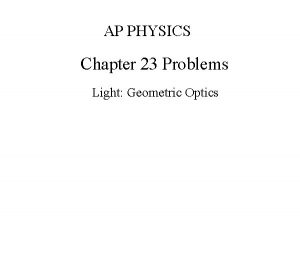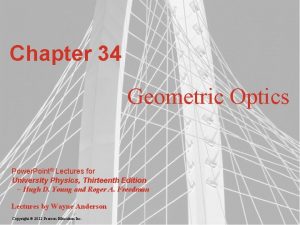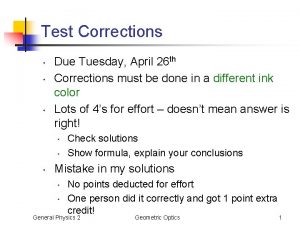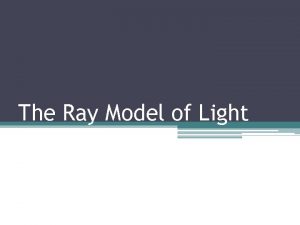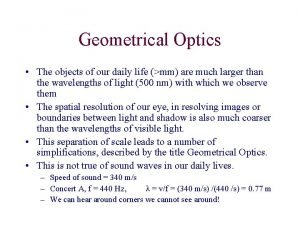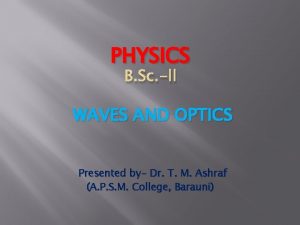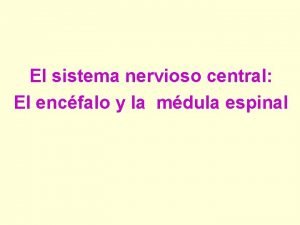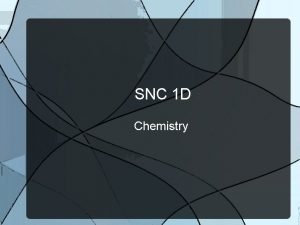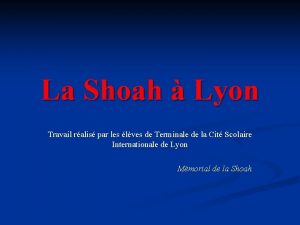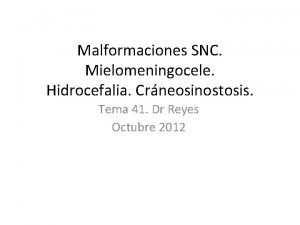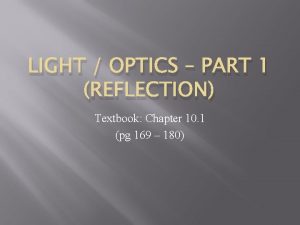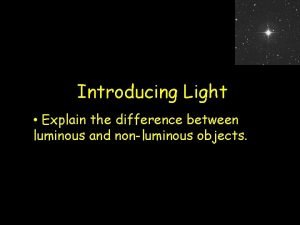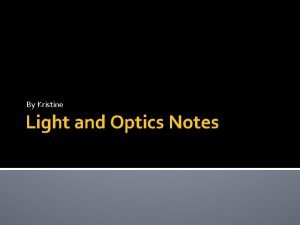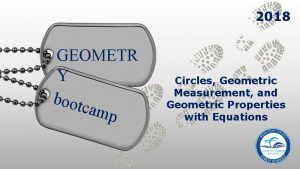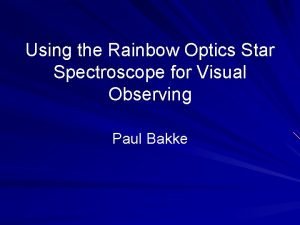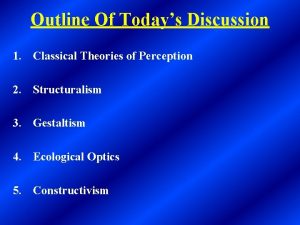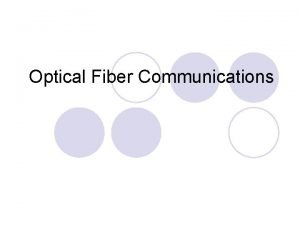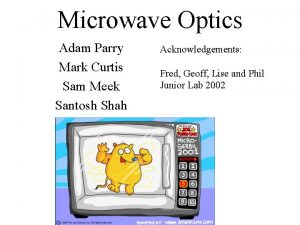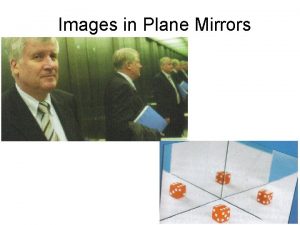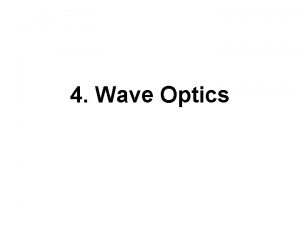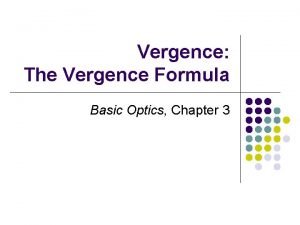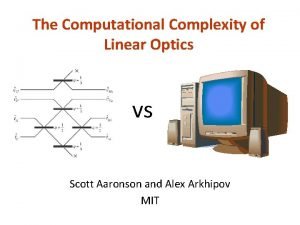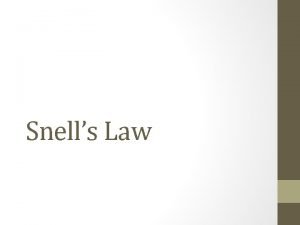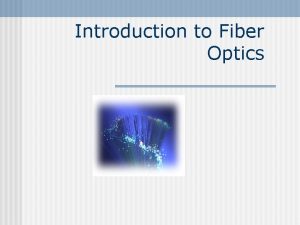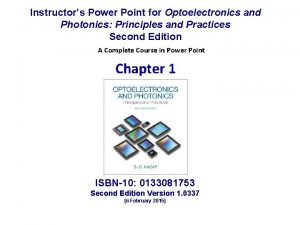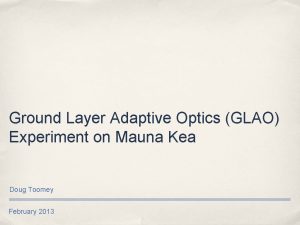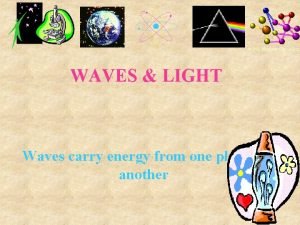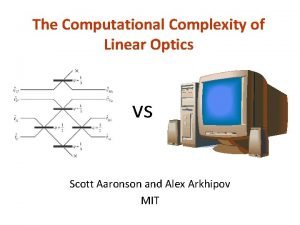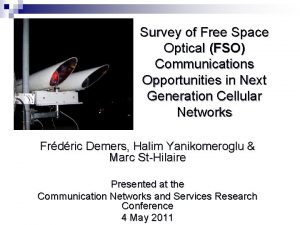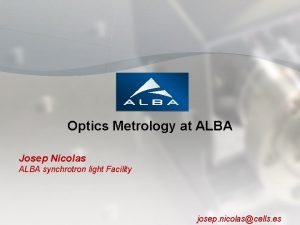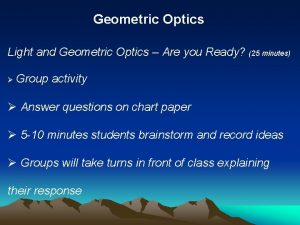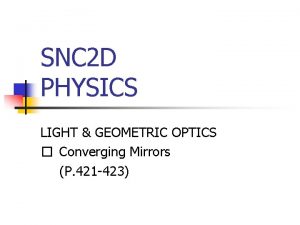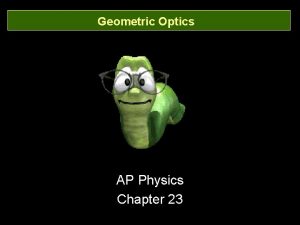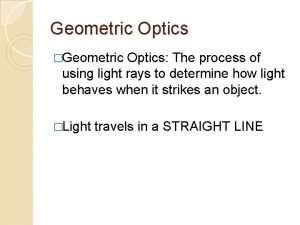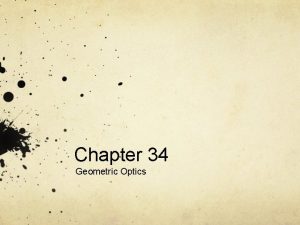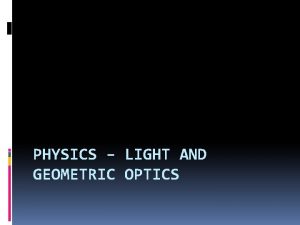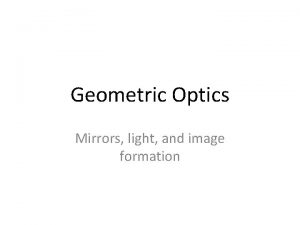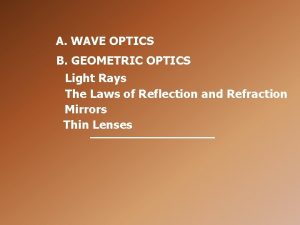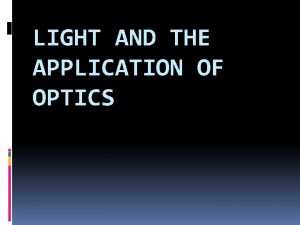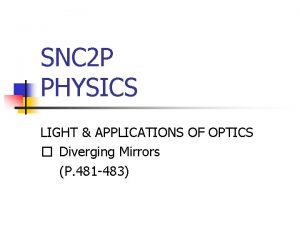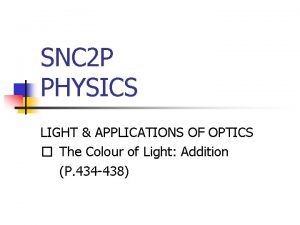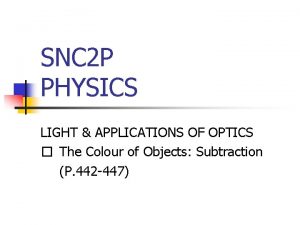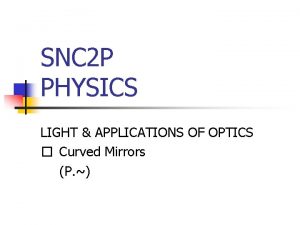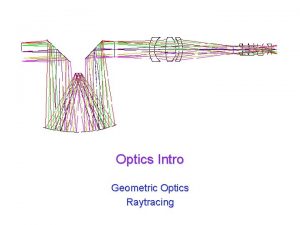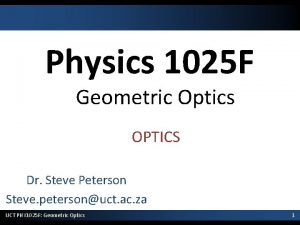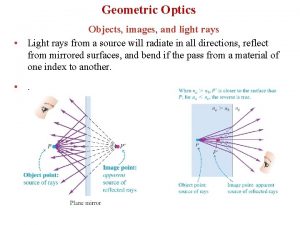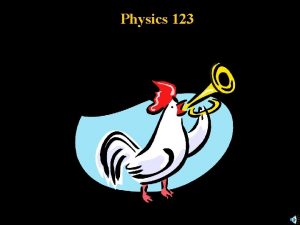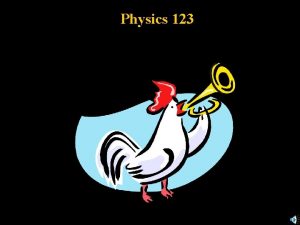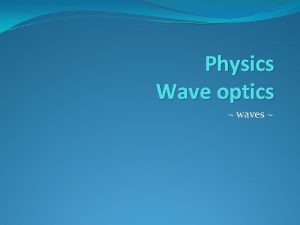SNC 2 D PHYSICS LIGHT GEOMETRIC OPTICS The














































- Slides: 46

SNC 2 D PHYSICS LIGHT & GEOMETRIC OPTICS � The Refraction of Light (P. 434 -436)

Activity: Observing Refraction (Part 1) INSTRUCTIONS A. Take a pencil and place it into a glass of water. B. Observe the glass from the side at various angles. December 14, 2021 2 DPHYS - The Refraction of Light 1

Activity: Observing Refraction (Part 1) QUESTIONS 1. What do you notice? the pencil appears to be bent at the air/water boundary December 14, 2021 2 DPHYS - The Refraction of Light 2

Activity: Observing Refraction (Part 2) INSTRUCTIONS C. Place a jar lid on a desk and put a coin close to the edge. (No lid? Use a Petri dish with some masking tape along the edge. ) D. Keep watching the coin while you lower the height of your head until the coin just disappears from view behind the rim of the lid. E. Keeping your head at the same level, pour water into the lid, on top of the coin. Record your observations. December 14, 2021 2 DPHYS - The Refraction of Light 3

Activity: Observing Refraction (Part 2) QUESTIONS 2. Why are you able to see the coin after the water was added? the water caused the light rays to be bend December 14, 2021 2 DPHYS - The Refraction of Light 4

What is Refraction? Light travels in straight lines through air. But what happens when it travels from one material into another? You likely have noticed that a spoon or stick, when placed in a glass of water, looks somewhat disconnected at the surface of the water. The spoon is not really disconnected. It is made of a solid material. So what is happening? December 14, 2021 2 DPHYS - The Refraction of Light 5

What is Refraction? When light crosses a boundary, for example, from water to air, the light is refracted. Refraction is the bending of light at the boundary of two transparent substances. The transparent substances are sometimes called media. While refraction causes some very interesting visual effects, it is more than just an optical curiosity. Refraction is used in designing and building camera lenses, eyeglasses, and telescopes. December 14, 2021 2 DPHYS - The Refraction of Light 6

What Causes Refraction? When a light ray moves from one medium into another, its speed changes. For example, the speed of a light ray in water is less than the speed of a light ray in air (see chart). It is the change in the speed of light that causes the refraction of light. NOTE! Since light travels faster in air than it does in water the air is the “fast” medium while the water is the “slow” medium. December 14, 2021 Medium Speed (km/s) air 300 000 ice 229 000 liquid water 226 000 vegetable oil 204 000 glass 197 000 ruby 170 000 diamond 124 000 2 DPHYS - The Refraction of Light 7

What Causes Refraction? LIGHT v travels at different speeds through different media v media are referred to as “fast” and “slow” December 14, 2021 Medium Speed (km/s) air 300 000 ice 229 000 liquid water 226 000 vegetable oil 204 000 glass 197 000 ruby 170 000 diamond 124 000 2 DPHYS - The Refraction of Light 8

What Causes Refraction? PRACTICE 1. The speed of light in glass is 197, 000 km/s while the speed of light in diamond is 124, 000 km/s. Which is the “fast” medium? since 197, 000 > 124, 000 the glass is the “fast” medium December 14, 2021 2 DPHYS - The Refraction of Light 9

What Causes Refraction? PRACTICE 2. As stated earlier, it is the change in the speed of light that causes the refraction of light. But why is there a change in the speed? December 14, 2021 2 DPHYS - The Refraction of Light 10

What Causes Refraction? To help visualize this phenomena, consider a child’s wagon being pulled at an angle from pavement (a “fast” medium) onto sand (a “slow” medium). When the right front wheel meets the sand, it slows down. The left front wheel does not slow down because it is still on the pavement. As a result, the wagon pivots about the slower right wheel. December 14, 2021 2 DPHYS - The Refraction of Light 11

What Causes Refraction? And the same way that the wagon changes direction when it travels from one surface to another, light rays change direction when they pass from one medium to another. December 14, 2021 2 DPHYS - The Refraction of Light 12

What Causes Refraction? REFRACTION v bending of light as it moves from one medium into another v caused by a change in the speed of light v the more the light slows down the more it bends (refracts) toward the normal December 14, 2021 2 DPHYS - The Refraction of Light 13

Rules of Refraction NOTE! Because the speed of light changes depending on the medium through which it is travelling, it is possible to make two general statements or rules about refraction and the angle of refraction (R) (i. e. the angle between the refracted light ray and the normal). December 14, 2021 2 DPHYS - The Refraction of Light 14

Rules of Refraction 1. When travelling from a “fast” medium into a “slow” medium (i. e. such as air to glass) the light slows down and bends toward the normal. In this case, the angle of incidence (i) is larger than the angle of refraction (R). fast �slow …… i > R December 14, 2021 2 DPHYS - The Refraction of Light 15

Rules of Refraction 2. When travelling from a “slow” medium into a “fast” medium (i. e. such as glass to air) the light speeds up and bends away from the normal. In this case, the angle of incidence (i) is smaller than the angle of refraction (R). slow �fast …… i < R December 14, 2021 2 DPHYS - The Refraction of Light 16

Rules of Refraction RULES OF REFRACTION � When light travels from a fast medium into a slow medium it: • slows down and • bends toward the normal (i>R) December 14, 2021 � When light travels from a slow medium into a fast medium it: • speeds up and • bends away from the normal (i<R) 2 DPHYS - The Refraction of Light 17

Rules of Refraction NOTE! Whenever a ray is normal to a boundary (i. e. i = 0� ), the transmitted or refracted ray continues in the same direction as the incident ray without bending (i. e. R = 0� ). However, partial reflection at the boundary still occurs. We can’t see the partially reflected rays because the reflected ray lies exactly on the incident ray. December 14, 2021 2 DPHYS - The Refraction of Light 18

Ray Diagrams of Refraction PRACTICE 3. According to the diagram, which is the fast medium – the air or liquid? December 14, 2021 2 DPHYS - The Refraction of Light 19

Dispersion A special kind of refraction occurs in both a diamond and raindrops. A diamond can appear completely colourless and yet glitter in all colours of the rainbow because the amount of refraction is different for each color. Since white light contains many colours, a single beam of white light can enter a diamond and be split into a whole rainbow of colours. This kind of refraction is called dispersion. Dispersion is the separation of white light into its individual spectral colours. December 14, 2021 2 DPHYS - The Refraction of Light 20

Dispersion The most common type of dispersion is in the formation of a rainbow. When sunlight passes through a raindrop, some of the light is reflected internally while some of the light is refracted twice, once on entering the raindrop and once on leaving. Both refractions cause the separation of the white sunlight into the colours of the rainbow. December 14, 2021 2 DPHYS - The Refraction of Light 21

Dispersion DISPERSION v separation of white light into its spectral colours v rainbows, prisms, … December 14, 2021 2 DPHYS - The Refraction of Light 22

Dispersion PRACTICE 4. How or why does refraction cause the separation of white light into its spectral colours? not only does light have a different speed in different media, each colour also has a slightly different speed in “slower” media such as water, diamond, … which results in the separation of the white light into its spectral colours December 14, 2021 2 DPHYS - The Refraction of Light 23

Refraction & Optical Illusions The refraction of light can cause optical illusions. An optical illusion is something that tricks the eye. December 14, 2021 2 DPHYS - The Refraction of Light 24

Refraction & Optical Illusions – Apparent Depth A pencil partly under water looks bent when viewed from above. We can explain this using the concept of refraction and the knowledge that our brains perceive light rays to always travel in a straight line. Light from the submerged pencil tip reaches your eyes. Your brain then projects the rays backwards in a straight line to create a virtual image in the water. December 14, 2021 2 DPHYS - The Refraction of Light 25

Refraction & Optical Illusions – Apparent Depth This virtual image is higher than the actual pencil tip, resulting in the pencil appearing to be bent. The pencil tip appears to be at a shallower depth than it really is. The distance from the surface of the water to where the object appears to be (the virtual image) is called the apparent depth. December 14, 2021 2 DPHYS - The Refraction of Light 26

Refraction & Optical Illusions – Apparent Depth Objects under water always appear to be nearer to the surface than they actually are. Apparent depth is an optical illusion. This is what makes fish or a paddle in water appear to be closer to the surface than they actually are. It also explains why the legs of someone standing in water appear to be shorter. December 14, 2021 2 DPHYS - The Refraction of Light 27

Refraction & Optical Illusions – Apparent Depth PRACTICE 5. An oar partly under water looks bent when viewed from above. Explain this phenomenon with the aid of a labelled ray diagram. December 14, 2021 2 DPHYS - The Refraction of Light 28

Refraction & Optical Illusions – Flattened Sunsets offer a unique opportunity to see an unusual image due to refraction. People notice that when the Sun is near the horizon during sunset, it appears to be flattened. The Sun, of course, is not really flattened. December 14, 2021 2 DPHYS - The Refraction of Light 29

Refraction & Optical Illusions – Flattened Sun When the Sun is close to the horizon, light from the bottom of the Sun is refracted more than light from the top of the Sun. Since air is more dense near Earth’s surface than higher up in the atmosphere the increased density of air closer to Earth results in greater bending of the Sun’s rays. December 14, 2021 2 DPHYS - The Refraction of Light 30

Refraction & Optical Illusions – Flattened Sun In addition, the light rays from the bottom of the Sun have a greater angle of incidence than the light rays from the top of the Sun. This results in the Sun having a flattened appearance. December 14, 2021 2 DPHYS - The Refraction of Light 31

Refraction & Optical Illusions – Shimmering Another application of refraction occurs when light passes through warm air, as it does above a hot stove. The refraction is not uniform, however, since the warm air is not uniform. As a result, light from objects seen through the warm air is distorted and the objects appear to shimmer. You can see the same shimmering effect over hot pavement in the summer or as jets go by. December 14, 2021 2 DPHYS - The Refraction of Light 32

Refraction & Optical Illusions OPTICAL ILLUSIONS v refraction cause various optical illusions including: • apparent depth • flattened sun • shimmering • … December 14, 2021 2 DPHYS - The Refraction of Light 33

Refraction & Optical Illusions – DYK? Researchers at the University of Costa Rica believe the metallic appearance of some species of beetles may help them go unnoticed by potential predators (their surface reflects light much like a water droplet so they appear as bright spots). The beetles have a cuticle which contains 70 separate layers of chitin. Each of the chitin layers have different refractive indices. Light reflected through a sequence of these chitin layers creates the beetles' metallic look. This is similar to the way in which a prism breaks white light into the colors of the rainbow by refraction. December 14, 2021 2 DPHYS - The Refraction of Light 34

�Check Your Learning 1. The diagram shows a ray travelling between two transparent media. (a) In which medium is light travelling faster? (a) medium A December 14, 2021 2 DPHYS - The Refraction of Light 35

�Check Your Learning 1. The diagram shows a ray travelling between two transparent media. (b) How do you know this? (b) � A>� B December 14, 2021 2 DPHYS - The Refraction of Light 36

�Check Your Learning 1. The diagram shows a ray travelling between two transparent media. (c) Can you tell which way the light is moving? Explain. (c) no – there are no arrows December 14, 2021 2 DPHYS - The Refraction of Light 37

�Check Your Learning 2. Why do your legs appear to be shorter when you are standing in water? optical illusion (apparent depth) – objects under water always appear to be nearer to the surface than they actually are December 14, 2021 2 DPHYS - The Refraction of Light 38

�Check Your Learning 3. Imagine you are looking at a fish in a pond. Would the fish appear to be closer to the surface or farther from the surface than it really is? Use a diagram to help explain your answer. December 14, 2021 2 DPHYS - The Refraction of Light 39

�Check Your Learning 4. What causes a diamond to sparkle? when light rays enter a diamond, they experience several total internal reflections before travelling back into the air – the sparkle is caused by these total internal reflections December 14, 2021 2 DPHYS - The Refraction of Light 40

�Check Your Learning 5. A scuba diver looks up and sees a seagull flying above the surface of the water. Is this a real or virtual image? Where is the seagull actually located? December 14, 2021 2 DPHYS - The Refraction of Light 41

Activity: The Refraction of Light QUESTION What happens to the path of light as it travels from one transparent medium into another? INSTRUCTIONS A. In your notebook, create a table similar to the one below. Type of Angle angle of incidence Size of angle 0� 10� 20� 30� 40� 50� 60� 70� angle of refraction in water (1. 33) angle of refraction in glass (1. 50) angle of refraction in custom (1. 60) December 14, 2021 2 DPHYS - The Refraction of Light 42

Activity: The Refraction of Light INSTRUCTIONS B. Open up the Ph. ET Physics “Bending Light” simulation. Ensure that the incident (1 st) material is air (n=1. 00) and the refractive (2 nd) material is water (n=1. 33). C. Place the protractor so the 90�marks line up with the surface of the boundary between the two media and the 0�marks line up with the dotted line. D. Turn the laser light on and change its orientation so that the angle of incidence is 0�. Measure and record the angle of refraction. E. Repeat step D for the remaining angles of incidence. F. Change the index of refraction (n) for the 2 nd material to (a) 1. 50 and (b) 1. 60 and repeat steps D and E. December 14, 2021 2 DPHYS - The Refraction of Light 43

Activity: The Refraction of Light QUESTIONS 1. When the angle of incidence in air was 0� , why was the angle of refraction 0� ? 2. Describe, with the aid of a diagram, how a refracted light ray in water (n=1. 33) bent in relation to the normal. 3. How did the results change when the 2 nd material was changed to glass (n=1. 50)? custom (n=1. 60)? 4. Which material (water, glass or custom) refracted the light most? Explain how you made this decision. 5. In which material (water, glass or custom) does light travel the fastest? Explain how you made this decision? 6. Explain how could you use the method in this activity to show that two transparent media, that appear to be identical, are actually different? How could you tell which media has a larger index of refraction? December 14, 2021 2 DPHYS - The Refraction of Light 44

�Check Your Learning WIKI (PHYSICS) �. . 2 DPHYS - WS 4 (Refraction) December 14, 2021 2 DPHYS - The Refraction of Light 45
 Reflection and refraction venn diagram
Reflection and refraction venn diagram Difference between ray optics and wave optics
Difference between ray optics and wave optics Geometric optics problems
Geometric optics problems Geometric optics ppt
Geometric optics ppt Geometric optics
Geometric optics Clearly explain what is meant by the term geometric optics.
Clearly explain what is meant by the term geometric optics. Geometric optics in everyday life
Geometric optics in everyday life Wave optics b.sc physics
Wave optics b.sc physics Skeleton hand whmis
Skeleton hand whmis Rombencefalo
Rombencefalo Snc1d chemistry
Snc1d chemistry Snc lajaa venissieux
Snc lajaa venissieux Società in nome collettivo
Società in nome collettivo Snc
Snc Paul mcenaney
Paul mcenaney Bill nye reflection and refraction
Bill nye reflection and refraction Difference between luminous and non luminous objects
Difference between luminous and non luminous objects Infrared light is also known as bill nye
Infrared light is also known as bill nye Light and optics notes
Light and optics notes Light light light chapter 23
Light light light chapter 23 Light light light chapter 22
Light light light chapter 22 Light light light chapter 22
Light light light chapter 22 2018 geometry bootcamp answers
2018 geometry bootcamp answers Rainbow optics star spectroscope
Rainbow optics star spectroscope Ecological optics
Ecological optics Turba optics
Turba optics Types of optics
Types of optics Adam ekt eva
Adam ekt eva Grade 10 optics review
Grade 10 optics review Charging by induction
Charging by induction Plane mirror characteristics
Plane mirror characteristics Hotwire fiber optics
Hotwire fiber optics Single slit envelope
Single slit envelope Optics topics
Optics topics Type of astigmatism
Type of astigmatism Fourier optics
Fourier optics Vergence formula optics
Vergence formula optics The computational complexity of linear optics
The computational complexity of linear optics Snells law example
Snells law example Introduction to fiber optics
Introduction to fiber optics Cauchy formula optics
Cauchy formula optics Adaptive optics
Adaptive optics Geometrical
Geometrical What medical procedure uses fiber optics bill nye
What medical procedure uses fiber optics bill nye The computational complexity of linear optics
The computational complexity of linear optics Free space optics
Free space optics Nicolas alba
Nicolas alba


